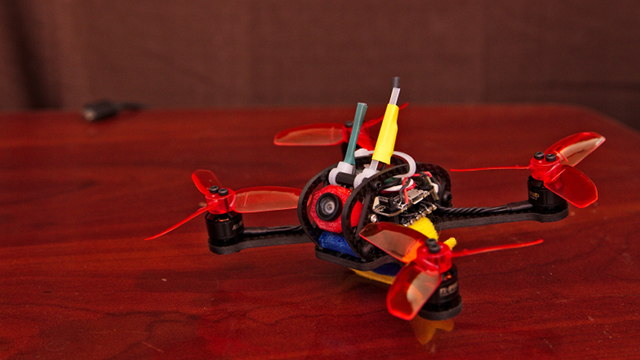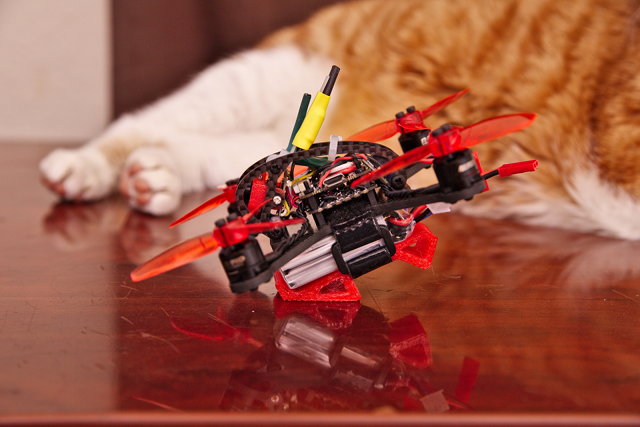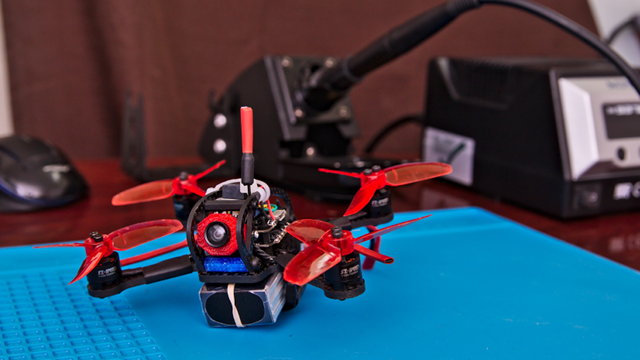Early last year, I discovered the KingKong 90GT micro drone, and it was fantastic. The 90GT is too big to fly indoors, but it was more than powerful enough to fight a strong breeze outside.
It didn’t take us long to figure out that we could relocate the motors to make room for bigger props. Upgrading from 1.9” to 2.5” props made it feel like a completely different quad! Thrust went up by 50% and I was getting an extra minute of flight time.
NOTE: The video above is from my old micro drone. It is the KingKong 90GT upgraded from 1.9” props to 2.5”.
These micro quads are a lot of fun to fly, and you can fly them in situations where a 5” racing quad might be inappropriate, or even dangerous. Ever since upgrading the KingKong 90GT, I’ve been on the lookout for a more powerful micro FPV quad.
- KingKong 90GT Upgrades at patshead.com
The KingKong FlyEgg 130 was a dud
As soon as I saw the KingKong FlyEgg 130, I asked my friends at Gearbest if they would send me one to review, and they were kind enough to oblige. It arrived with a faulty camera. I was impatient, so I soldered my old KingKong 90GT camera into its place. It didn’t quite fit the frame, but I was able to make it work.
My first flight seemed extremely promising. It was an upgrade in every possible way over the KingKong 90GT, but I had a crash on my second battery, and I managed to bend a motor. That was the beginning of the end, and I hadn’t even flown the FlyEgg for 10 minutes yet!
- KingKong FlyEgg 130 at Banggood
Failing to upgrade the FlyEgg 130
I figured it might be worthwhile to install some premium motors on the FlyEgg 130, so I ordered a set of Brotherhobby 1106 motors. The number 3 motor was problematic. I could hover, but if I hit the throttle, it would fall out of the sky. I tried adjusting motor timings, increasing minimum throttle, swapping out motors, and even replacing the 4-in-1 ESC. Nothing would help.
I even ordered a replacement 4-in-1 ESC, but I still had the same problem. I’d sunk enough time and money into making this work. I was bummed out, and I didn’t even want to think about the FlyEgg 130 anymore.
It looks like they’re using entirely different motors on the KingKong FlyEgg 130 now. Maybe the new motors aren’t as soft as the original ones! Even so, I don’t imagine the FlyEgg 130 is worth the additional cost compared to the Leader 120.
- KingKong FlyEgg 130 at Banggood
- Brotherhobby Returner R3 1106 motors at Banggood
The Leader 120 is amazing
I got an email from Gearbest telling me the Leader 120 micro FPV quad was on sale for about $80! I’d never heard of it, so I looked for flight videos on YouTube. It looks like there were some issues with the earliest batch, but it sounds like all the problems are ironed out now.
The Leader 120 is an upgrade in every way over my beloved KingKong 90GT. The Leader 120 has bigger motors, bigger props, a better camera, more modern flight controller, and it can run on a 3S battery. Full Speed managed to cram all this hardware into a quad that costs 30% less than my 90GT!
- Leader 120 Micro FPV Quad at Gearbest
- Leader 120 Micro FPV Quad at Banggood
2S or 3S batteries for the Leader 120?
I already had a handful of 550 mAh 2S LiPos for my KingKong 90GT. I also had a 400 mAh 3S and a 550 mAh 3S on hand for the KingKong FlyEgg 130. This gave me a good base for experimentation!
The Leader 120 flies amazingly well on 2S. If you’re just watching it cruise around, you probably wouldn’t notice that it isn’t flying on 3S. It is fast on 2S, and has decent punch. If you’re trying to do acrobatics, you’ll really appreciate a 3S battery.
I enjoyed the Infinity 550 mAh 3S batteries, so I ordered half a dozen for myself. The Leader 120 is super fast on 3S. We clocked it at 69 MPH with the radar gun! I’m confident that I could squeeze a little more out of it. I’d sure like to see a speed gun run break 70 MPH.
- Leader 120 Micro FPV Quad at Gearbest
- Leader 120 Micro FPV Quad at Banggood
- Infinity 550 mAh 2S/3S Batteries at Banggood
I had to order a Leader 120 for my nephew
I ordered a second Leader 120 as soon as I got home from the maiden flight of my own Leader 120. It is a fast, agile, stable, and sturdy little quadcopter. We gave my nephew a full FPV setup including a BFight 210 for Christmas. I figured an amazing and inexpensive drone like the Leader 120 would be an excellent addition to his hangar.
I sent him the Leader 120 and all my 450 and 550 mAh 2S batteries. The Leader 120 flies quite spiritedly on 2S, but I imagine it will be tame enough that he can have fun flying it around in his neighborhood.
- Giving the Gift of an FPV Quadcopter at patshead.com
The Leader 120 is a Plug-N-Play drone
What does Plug-N-Play mean? I’m not entirely sure that there’s a standardized definition. Usually it means the quad ships with everything up to but not including the receiver. You get the quad with motors, flight controller, camera, video transmitter, and a battery.
You don’t get a receiver, radio transmitter, or FPV goggles. The Leader 120 is compatible with most serial receivers, including FrSky, FlySky, and Spektrum.

I had a spare FrSky compatible D8 serial receiver, and that’s what I used for the first few weeks. It was the cheap receiver that shipped with my BFight 210. It doesn’t have diversity, and the range is terrible. I had a few failsafes with it when I was flying right near the edge of video range. That’s only a few hundred feet with the Leader 120’s tiny 25mw VTX.
I upgraded my Leader 120 to a real FrSky R-XSR receiver. Now it can fly as far as any of my full-size miniquads, assuming I can still see the video. There was even a free UART pad for telemetry, and the Betaflight LUA scripts even let me adjust the PIDs!
I reused the generic D8 FrSky-compatible receiver in our nephew’s Leader 120. It should work well for him, and the reduced range should help keep him out of trouble. If you’re flying with a Taranis radio, I’d recommend using at least an XM-Plus receiver. They’re small, reliable, and have excellent range.
- Leader 120 Micro FPV Quad at Gearbest
- Leader 120 Micro FPV Quad at Banggood
- Infinity 550 mAh 2S/3S Batteries at Banggood
- FrSky R-XSR receiver at Amazon
- FrSky XM-Plus receiver at Amazon
Are these tiny micro FPV quads worth the money?
This is extremely subjective. It will depend on your circumstances, and my own opinion on micros has shifted a bit with all the progress that’s been made since my beloved KingKong 90GT.
My good friend Brian enjoyed his 90GT at least as much as I did, and that convinced him that he wanted to build a premium 3” micro quad. The parts for that micro have cost him more than $300, but he’s had a lot of fun building it, and he enjoys flying it. He’s also been constantly upgrading it!
That’s about what it cost me to build an amazing 6S-capable 5” FPV quad using premium parts: T-Motor F40 Pro v2 motors, 35a BLHeli_32 ESCs, a nice F4 flight controller, and a premium smartaudio VTX on an OwlRC Dragon frame.
You can get a fantastic beginner-level 5” quad like the BFight 210 for around $140. That’s less than the price of many of the micro quads, and the BFight flies a lot better than a micro.
That’s the problem with most of the micro quads. They’re fun to fly, but they don’t feel nearly as locked in as a 5” racing quad. Fortunately, they’re getting closer and less expensive!
The Leader 120 handles so much more like a real racing quad than my KingKong 90GT ever did. It isn’t quite there yet, but that gap is no longer a huge chasm. The Leader 120 costs less than $90. My weaker, slower KingKong 90GT cost about $130. I am amazed at what you can get for your money.
That said, 5” quadcopters still offer the best value. There has been a lot of competition at that scale for a long time. There’s no shortage of motors, ESCs, and flight controllers at many price points in the 5” class. The bigger quadcopters are also easier to work on and repair.
- Leader 120 Micro FPV Quad at Gearbest
- Leader 120 Micro FPV Quad at Banggood
- Infinity 550 mAh 2S/3S Batteries at Banggood
- BFight 210 FPV Racing Quadcopter at patshead.com
- KingKong90GT: Learning to FPV at Brian’s Blog
- Brian’s Pseudo Micro Quadcopter at Brian’s Blog
So why would I want a micro quad?!
You can fly a micro quad in many situations where a big, angry 5” quad would be inappropriate. A 5” racing quad sounds scary. They’re heavy enough that they carry a lot of momentum. I wouldn’t want to be hit with a 600-gram quad that is ripping through the air at 85 MPH.
Fewer people will notice your 2.5” or 3” micro quad. They’re quiet. They don’t usually travel as fast as a 5” quad, and they weigh less than 140 grams. It would be much harder to smash through a windshield with a micro quad, and I’d be surprised if anyone would bleed out if they got cut by a prop.

I don’t advocate flying your 3” micro in crowds, but they’re much more suitable to smaller spaces than a full-size miniquad. Last week, we were in a huge, open field at a park. We fly there a lot, and there’s usually plenty of room for us. That wasn’t the case for a significant window of time on our last trip.
To one side was the parking lot, our pilots, and spectators. In another direction, there was a guy slowly walking his dog. Then another group of people showed up and meandered around. We were effectively boxed into a triangle for about twenty minutes. Even at a slow pace, we were always two or three seconds away from being dangerously close to something.
I’m happy to have the Leader 120 in my bag, because it let me fly two or three batteries while everyone else was effectively grounded. I’m certain that I’ll always carry a micro with the rest of my quads. It doesn’t take up a lot of space in my cavernous backpack, and it is a ton of fun to fly!
- Leader 120 Micro FPV Quad at Gearbest
- Leader 120 Micro FPV Quad at Banggood
- Infinity 550 mAh 2S/3S Batteries at Banggood
Should your first FPV quad be a micro?
My friend Brian and I talk about this all the time. He spent a lot of his time early on flying his KingKong 90GT. I agree that it was a fantastic way to practice and gain confidence, but it eventually turns into a hindrance. We just couldn’t fly our KingKong 90GT like a full-size miniquad. You have so much more control when you fly a heavier 5” racing quad, and the 90GT didn’t have enough thrust to recover from acrobatic maneuvers.
These points have always made me discourage people from starting with a micro quad. You’ll hit your skill ceiling pretty quickly, and you won’t be able to advance any farther. I tend to encourage people to start with a real miniquad like I did.
Except I didn’t start flying with a full-size miniquad. You could easily argue that my PH145 was an overweight, overgrown micro quad. It was heavy, so I wouldn’t notice a gentle breeze like I would in a real micro, but it was relatively safe and under-powered.
I’m officially changing my advice. Modern micro quads like the Leader 120 are fantastic. They feel more like a 5” racer than the KingKong 90GT ever could. I don’t see any problem starting your FPV journey with a 2.5” or 3” micro quad. It is a safe, inexpensive, and fun way to enter the hobby!
- Leader 120 Micro FPV Quad at Gearbest
- Leader 120 Micro FPV Quad at Banggood
- Infinity 550 mAh 2S/3S Batteries at Banggood
UPDATE: I crashed my Leader 120 really hard!
Last week, I upgraded my Leader 120 to Betaflight 3.2.4. I copied the stock PIDs over. I expected that would be a good starting point for tuning, but I didn’t even have to do anything. Snap rolls and flips are locked in. There’s still some prop wash, but it isn’t bad.
I assumed the Betaflight default minimum throttle of 4.5% was too high, so I dropped it to 3.5%. It seemed to be flying just fine like that. The Leader 120 has trouble if your minimum throttle is too low. I did a bunch of sharp, snappy moves with the 3.5% setting, and it was fine.
Then I tried to power loop a tree. This was really hard to do out of the box, because the min throttle is set to around 10%. As soon as you go inverted with that 10% minimum, you are seemingly racing towards the ground. My memory was wrong while I was at the field, and I assumed 4.5% was the default.
My power loop yesterday went great at first, but my low minimum throttle setting was way too low. One of the motors didn’t spin back up fast enough, and I spun out of control at the very top of my loop and crashed into the sidewalk.
I broke a beefy battery strap—a battery strap meant for 5” quads! My battery ejected, and I even bent and arm. I was able to bend it back, but I wasn’t able to fly again that day. I didn’t have any appropriate battery straps with me in the field.
I bent the arm and props back into shape. I hovered it at home, and it seems like it will be fine. It is going to be raining all week. I can’t wait to get out to try it again.
I’m proud of the little guy. Any crash that can break a 20mm battery strap is a hard crash. He held up very well!
Final thoughts
The Leader 120 is an amazing piece of hardware, and its price point is nothing short of amazing. For $90, you get a surprisingly good micro CMOS camera, peppy and durable motors, durable props, and a fast, smooth flying experience. I have no idea how you can beat this combination of price and performance.
The Leader 120 isn’t perfect, but I didn’t expect perfection for $90. My only serious complaint about the Leader 120 is its 25mw VTX. As long as you’re in range, it works quite well. The Leader 120 may be tiny, but it is super fast—especially when using a 3S LiPo. It takes no time at all to reach the end of your reliable video range.

In practice, that’s a minor complaint. The farther you fly, the harder it is to recover your quad when it crashes. The difficulty only increases when you’re flying a micro. Even freshly mowed grass is deep enough to almost completely conceal one of these tiny quads. Staying within a few hundred feet with a micro is a good idea anyway.
Do you fly a Leader 120 or one of the other Full Speed micro quads? Do you have a micro quad that you prefer? Are you flying micro quads or other FPV quads near Plano, TX? Post a comment, or come chat with us in the drone channel on our Discord server!
- Leader 120 Micro FPV Quad at Gearbest
- Leader 120 Micro FPV Quad at Banggood
- Infinity 550 mAh 2S/3S Batteries at Banggood
- FrSky R-XSR receiver at Amazon
- FrSky XM-Plus receiver at Amazon
- KingKong90GT: Learning to FPV at Brian’s Blog
- Giving the Gift of an FPV Quadcopter at patshead.com